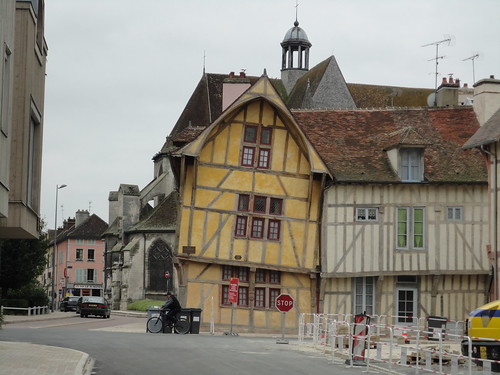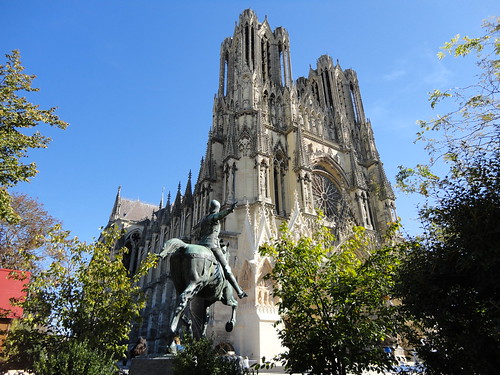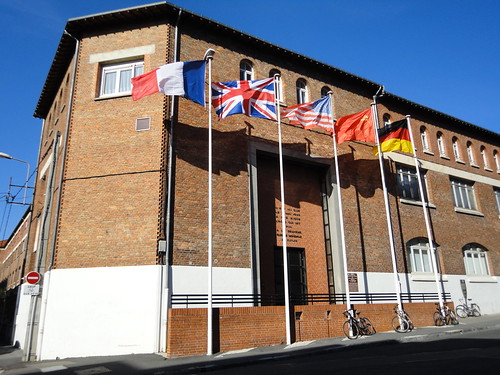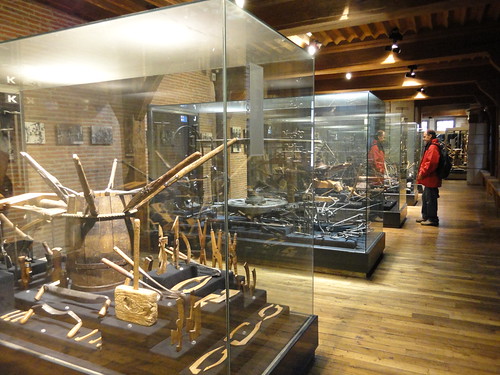Medieval Troyes and Ceremonial Reims
Our October sojourn in the French Valley of the Kings had drawn
to a close for us. It was time to leave
the land of forested estates. Where the
rich, the elite and the aristocratic can be seen gathered on Sundays in hunting
parties dressed in period costumes atop their horses, accompanied by a
traditional horn blower and packs of hounds. Where gateau-like chateaux adorn the
landscape. Where fairytales, fantasies
and follies come to life.
So we left Fantasia Land (ie, the Loire Valley) to head
towards another well-known area of France – Champagne, the Land of Bubbly. Eastward
bound we travelled deeper into colder weather and greyer skies. After weeks of gorgeous sunshiny high 20’s it
was now downright gothic and wintry.
TROYES
First stop – Troyes – for several days. Two reasons drew
us here. It was the ancient and original capital of Champagne filled with
half-timbered medieval houses ….and……. strangely, factory outlet
shopping districts, according to our Lonely Planet guidebook. Whoa, we’d held back on consumerist pleasures
such as retail therapy for most part of this long-haul trip and now, nearing
the end of it, we were in the mood to let those euros shake loose from pockets
and purses.
 |
| Troyes after rain |
What did we discover apart from heaps of affordable
international brand name labels and it being the home of Lacoste? This town is the origin for the name “troy
weight” - the unit of measure for gold.
In the heart of the city whose layout resembles the outline of a champagne cork, Troyes is a delightful-to-explore-by-foot place (even in pouring rain) that has beautifully preserved its medieval small town charm. Narrow cobblestoned streets and town squares are bordered by pretty half-timbered buildings, some of which slant more precariously than the Leaning Tower of Pisa. Some streets and laneways have great names such as the dark and narrow Ruelle des Chats (Cats Alley).
In the heart of the city whose layout resembles the outline of a champagne cork, Troyes is a delightful-to-explore-by-foot place (even in pouring rain) that has beautifully preserved its medieval small town charm. Narrow cobblestoned streets and town squares are bordered by pretty half-timbered buildings, some of which slant more precariously than the Leaning Tower of Pisa. Some streets and laneways have great names such as the dark and narrow Ruelle des Chats (Cats Alley).
 |
| After a few champagnes you could be forgiven for thinking that you weren't seeing straight |
 |
| Ruelle des Chats |
 |
| Detail of Sts Crispin and Crispinian, patron saints of shoemakers in Eglise St Pantaleon, Troyes |
TOOL MUSEUM - SERIOUSLY GOOD
A fascinating stop was at the Maison de l’Outil, Troyes’ tool museum – it was seriously good. Housed in a historic multi-storeyed creaky 16th century building was a vast collection of around 10,000 tools from bygone trades and eras. Carvers, coopers, milliners, butchers, carpenters, stone masons, upholsterers, glovemakers, you name it, all crafts were represented. This place is a shrine to the art of manual labour. |
| Max stands in courtyard of Troyes' Tool Museum, above and in front of one of its many collections |
REIMS
A memorable daytrip from Troyes was to Reims, the coronation
capital of many of France’s kings. To pronounce it is something like “Rance”
but rolling the ‘rrrrrrr’ and saying it as if you have a blocked nose. Here we were entertained by buskers and acts
around the town’s café-lined squares and visited the fascinating and massive statue-encrusted
Reims’ Notre Dame Cathedrale where Joan of Arc stood by Charles VII at his
coronation.
We ate a bison sausage hot dog and bison hamburger for lunch at an outdoor Canadian promotional event (rather tasty) and stood sombrely in Eisenhower’s and the Allied’s map room in the Surrender Museum (Musee de la Reddition) where the Nazi Germans surrendered to the Allies, effectively ending WWII. There’s so much more to explore in Reims, including Roman ruins as well as the champagne houses of Taittinger (a little out of town) and Mumm – however, we were saving the champagne tasting for Epernay. A daytrip certainly cannot do justice to such a richly historic town, but at least we tried.
We ate a bison sausage hot dog and bison hamburger for lunch at an outdoor Canadian promotional event (rather tasty) and stood sombrely in Eisenhower’s and the Allied’s map room in the Surrender Museum (Musee de la Reddition) where the Nazi Germans surrendered to the Allies, effectively ending WWII. There’s so much more to explore in Reims, including Roman ruins as well as the champagne houses of Taittinger (a little out of town) and Mumm – however, we were saving the champagne tasting for Epernay. A daytrip certainly cannot do justice to such a richly historic town, but at least we tried.
 |
| Horsemounted Joan of Arc faces the Reims Notre Dame Cathedral |
 |
| A few examples of over 2000 statues at the Reims Cathedral |
 |
| Surrender Museum, Reims |
This was the one day we decided not to drive and instead caught the train to Reims – 22 easy minutes there, 3 long weary hours on the return due to a power failure on the train tracks. We sat patiently in the train-to-nowhere with other passengers for over 1 ½ hours whilst railway authorities decided what to do, then shepherded like a sheep flock to a bus stop where we stood outside shivering in the cold for a further half an hour waiting for a bus that never arrived and finally ushered back again onto the railway platform to catch a slow train to Troyes.
Two fabulous Champagne cities explored. Onwards next to other
places within the Champagne province loaded down with our many clothing purchases
(more Max’s than mine!) squeezed into a brand new mini-suitcase which is
crammed alongside our swollen backpacks in the small car boot.




 Hi, I'm Eva - world traveller, cultural explorer and experience seeker. Together with my husband Max, we've been globetrotting for over 20 years.
Hi, I'm Eva - world traveller, cultural explorer and experience seeker. Together with my husband Max, we've been globetrotting for over 20 years.







0 comments: